
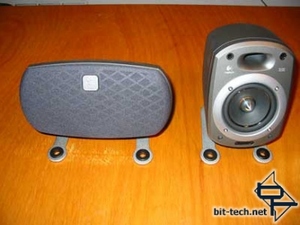
Just a group shot of the difference between the surround satellite and the center channel unit. I removed the cover on the satellite to give you view of it. Looks like the polished business end of an artillery shell. The covers are pressure fitted on and very easy to remove and have a solid hold when you put them back on so you can decide what look you want to go with... wolf or throw some sheep's clothing on it.
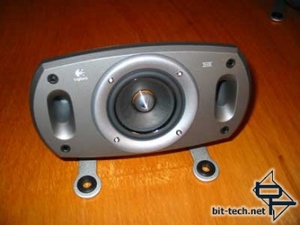
Center channel speaker sans-fabric cover.
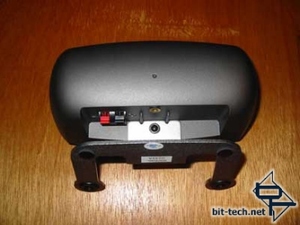
The center satellite has the same spring clamp wire mounts as the subwoofer.

The surround satellites have threaded nuts which makes a lot of sense. Ideally, you will be setting these up in a corner somewhere and hopefully, never touch them again. The threaded nut connectors insures a solid/reliable connection.
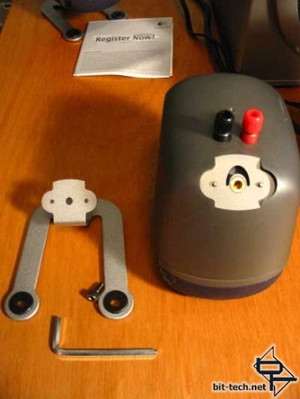
The speakers arrive in the "stand up" mode as far as the bases are concerned but Logitech has an ingenious idea in mind for mounting flexibility. Using the included hex key, you can remove the single screw that holds the base to the speaker. You can then rotate the base 180 degrees and put it in "wall mount" mode. Notice that the base includes the little feet that provide cushion in standing mode and screw mounting holes for wall-mount mode. Simple and effective and once the hex screw is tightly fastened... solid.
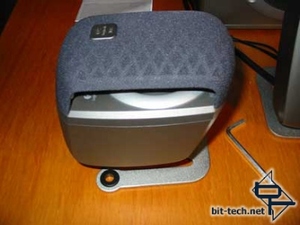
The speaker reconfigured in wall-mount mode.
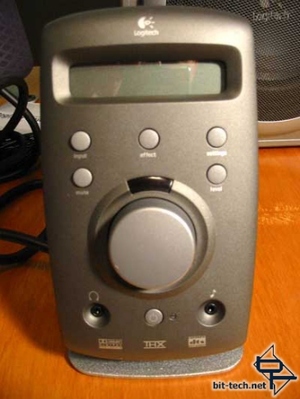
The control console is quite the monolith but this baby has a lot going on inside. It allows you to adjust everything from channel levels, digital effects and settings, to selecting the input. It also acts as the receiver for the remote and allows you to plug headphones or external devices such as MP3 or minidisk players. Basically, this is your Dolby Surround Sound receiver.
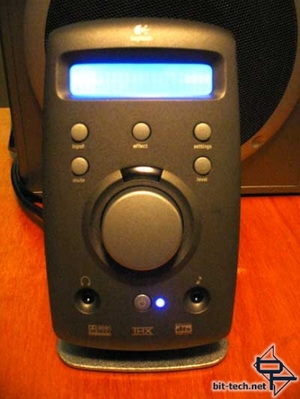
When powered it has nice effects like the bloo backlit LCD display and the power LED indicator. The display is a little washed out and really difficult to capture with the camera. But, it is an improvement over the famous bloo LED searchlight that lives in the Z-340 main satellite. I have a permanent image of that LED burned into my cornea.
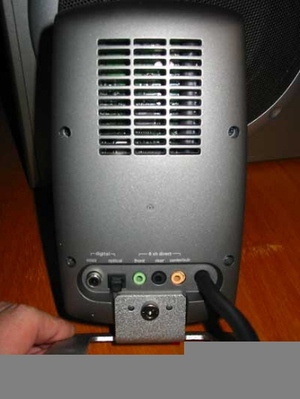
The back of the control console shows the input options: digital coaxial, optical, and analog inputs.
The only input solution provided with the product is of the analog nature. At first, I was a bit disappointed by this but in reality, beyond analog, it would be hard for Logitech to predict what hardware you have to support your speakers. Although optical connections are fast becoming common in even on-board motherboard breakouts, they still hasn't proliferated the market yet. So I will need to get my own digital cable. Since I plan on using the m-Audio Revolution 7.1 audio card, I will have to be a digital coaxial since it doesn't support optical. Which goes to prove my point about Logitech guessing what people are going to use. The time being, everyone has analog connections, no sense including cables that you know at least one of them won't be used and going to waste I guess. And of course, because you have three types of connections to interface, and control over what input the control module uses in the menu system, you could connect multiple devices to it such as your PC and your stereo receiver... just a thought.
On the subject of wiring. Logitech includes two 6' pieces of speaker wire and three 15' pieces. The quality of wire is satisfactory but purists will probably opt for their own after-market wire that would most likely include a lot more copper than the stuff Logitech included. The wire amounts they include should suffice for a common desktop setup. But, to install these properly (I will wag my finger about this later) you will probably be needing some longer runs for the rear surround channel setup installation. So, if you plan on running right out to your local electronics store after reading my review to buy these babies, you might want to put some decent speaker wire on your list as well so you don't end up having to make a last minute run right back to the store.

MSI MPG Velox 100R Chassis Review
October 14 2021 | 15:04








Want to comment? Please log in.